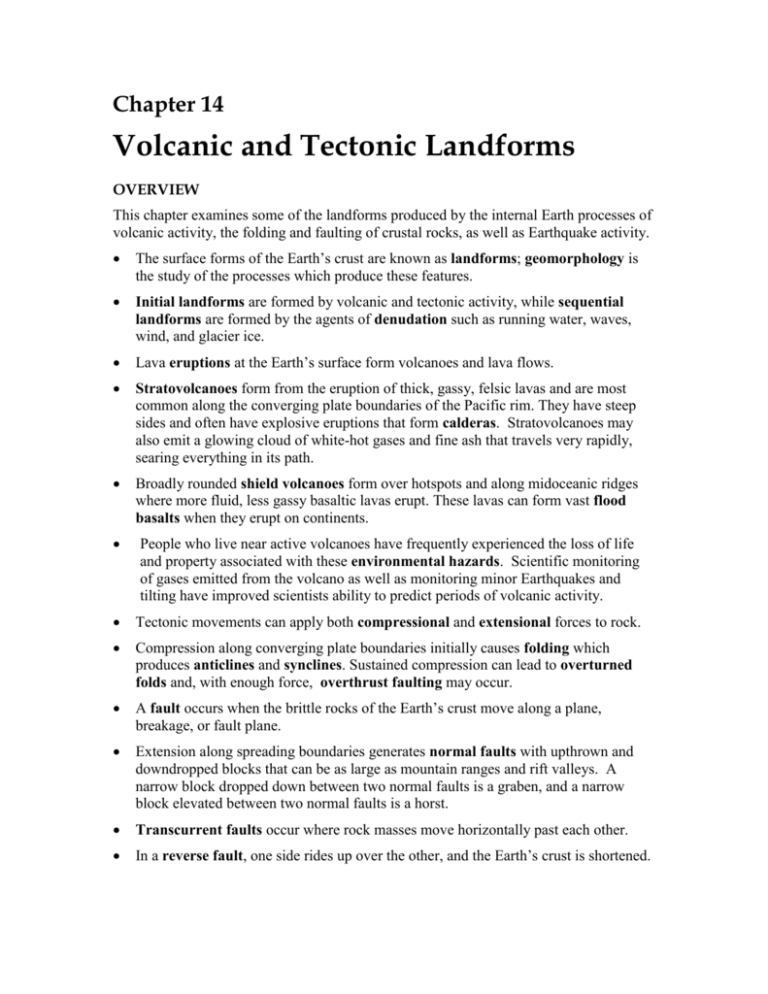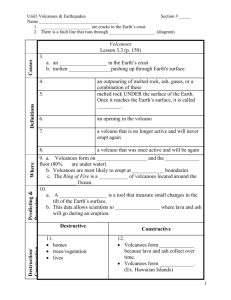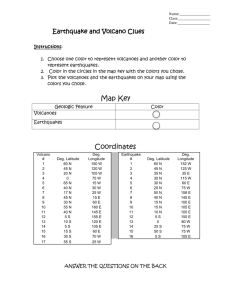On-Line Study Guide
advertisement

Chapter 14 Volcanic and Tectonic Landforms OVERVIEW This chapter examines some of the landforms produced by the internal Earth processes of volcanic activity, the folding and faulting of crustal rocks, as well as Earthquake activity. The surface forms of the Earth’s crust are known as landforms; geomorphology is the study of the processes which produce these features. Initial landforms are formed by volcanic and tectonic activity, while sequential landforms are formed by the agents of denudation such as running water, waves, wind, and glacier ice. Lava eruptions at the Earth’s surface form volcanoes and lava flows. Stratovolcanoes form from the eruption of thick, gassy, felsic lavas and are most common along the converging plate boundaries of the Pacific rim. They have steep sides and often have explosive eruptions that form calderas. Stratovolcanoes may also emit a glowing cloud of white-hot gases and fine ash that travels very rapidly, searing everything in its path. Broadly rounded shield volcanoes form over hotspots and along midoceanic ridges where more fluid, less gassy basaltic lavas erupt. These lavas can form vast flood basalts when they erupt on continents. People who live near active volcanoes have frequently experienced the loss of life and property associated with these environmental hazards. Scientific monitoring of gases emitted from the volcano as well as monitoring minor Earthquakes and tilting have improved scientists ability to predict periods of volcanic activity. Tectonic movements can apply both compressional and extensional forces to rock. Compression along converging plate boundaries initially causes folding which produces anticlines and synclines. Sustained compression can lead to overturned folds and, with enough force, overthrust faulting may occur. A fault occurs when the brittle rocks of the Earth’s crust move along a plane, breakage, or fault plane. Extension along spreading boundaries generates normal faults with upthrown and downdropped blocks that can be as large as mountain ranges and rift valleys. A narrow block dropped down between two normal faults is a graben, and a narrow block elevated between two normal faults is a horst. Transcurrent faults occur where rock masses move horizontally past each other. In a reverse fault, one side rides up over the other, and the Earth’s crust is shortened. Earthquakes occur when tectonic forces cause rock to suddenly fracture and move, shaking the ground in the vicinity of the fracture Submarine Earthquakes can produce sea waves known as tsunami. The Richter scale is a logarithmic scale used to measure the energy released by an Earthquake. Most severe Earthquakes occur along lithospheric plate boundaries. KEY TERMS landform geomorphology denudation volcano stratovolcano shield volcano folding anticline syncline overturned fold fault normal fault horst graben transcurrent fault reverse fault overthrust fault Earthquake tsunami STUDY QUESTIONS 1. Distinguish between initial and sequential landforms. 2. Define denudation, and give three examples of denudation agents. 3. Discuss the way in which the internal Earth processes and denudation processes interact to produce landforms. 4. Two major types of volcanoes are stratovolcanoes and shield volcanoes. How do these two types of volcanoes differ in their shape, material composition, and usual position on lithospheric plates? 5. What is the difference between a hot spring and a geyser? 6. What are compressional and extensional tectonic activity and where do these usually occur? 7. Sketch a cross-section of an anticline, a syncline, and an overturned fold. 8. Sketch a cross-section of a normal fault and a reverse fault. Label the fault plane, upthrown side, downthrown side, and fault scarp on both cross-sections. 9. What is a transcurrent fault, and what are some of the ways it might be expressed on the land surface? 10.Describe the global pattern of earthquake occurrence, and discuss how this is related to plate tectonics. 11.Describe the cause and behavior of a tsunami. 12.How is the Richter scale used to characterize earthquakes? 13.Use the example of the Hawaiian island volcanoes to explain and illustrate the concept of a life cycle. CHAPTER QUIZ Multiple Choice Questions 1. Stratovolcanoes are composed of: a) broadly rounded dome shapes, typically 2. 3. 4. 5. b) interlayered tephra and felsic lava c) both a and b d) neither a nor b Which of the following is not produced by compressional tectonic activity? a) anticline b) overthrust fault c) normal fault d) reverse fault The great central depression produced by explosive eruption of volcanoes is called a: a) flood basalt b) hot spot c) caldera d) tephra A one integer increase on the Richter scale represents an increase in Earthquake energy release of: a) two b) ten c) thirty-two d) 1032 Which of the following would most clearly suggest the presence of a near-surface geothermal energy source? a) geyser b) graben c) tsunami d) horst True/False Questions 1. 2. 3. 4. 5. All rock faults are the result of extensional tectonic activity. (T/F) Earthquakes can occur in continental areas far from plate boundaries. (T/F) Most of the world’s shield volcanoes lie in the circum-Pacific mountain belt. (T/F) Tsunami are not perceptible at sea in deep water. (T/F) Flat lying strata that undergo severe extensional stress can experience folding. (T/F) Short Answer Questions 1. Most of the world’s active stratovolcanoes lie within the circum-Pacific belt. Why? 2. Why is the possibility of landsliding often greater along a reverse fault scarp than along a normal fault scarp? 3. Why do tsunami pose an environmental hazard? Short Essay Questions (1 - 2 paragraphs) 1. Outline the cause of the high Earthquake hazard in southern California. 2. Describe the life cycle of a Hawaiian volcano. Internet Resources 1. Photo glossary of volcano terms: <http://volcanoes.usgs.gov/Products/Pglossary/pglossary.html> 2. US Geological Survey Volcano Hazards Program: <http://volcanoes.usgs.gov/> 3. US Geological Survey Earthquake Hazards Program: <http://Earthquake.usgs.gov/> 4. The Savage Earth - Information on Earthquakes, volcanoes, and other tectonic features including animations of tectonics, volcanic activities, and landforms: <http://www.pbs.org/wnet/savageEarth/> 5. A huge source of volcano photos and links: <http://www.volcanoes.com/> 6. An online volcanology textbook by Robert I. Tilling of the United States Geological Survey: <http://pubs.usgs.gov/gip/volc/> 7. Student-teacher ThinkQuest Program - Volcanoes on-line: <http://library.thinkquest.org/17457/english.html> 8. The Smithsonian Institute Global Volcanism Program: <http://www.volcano.si.edu/gvp/>







